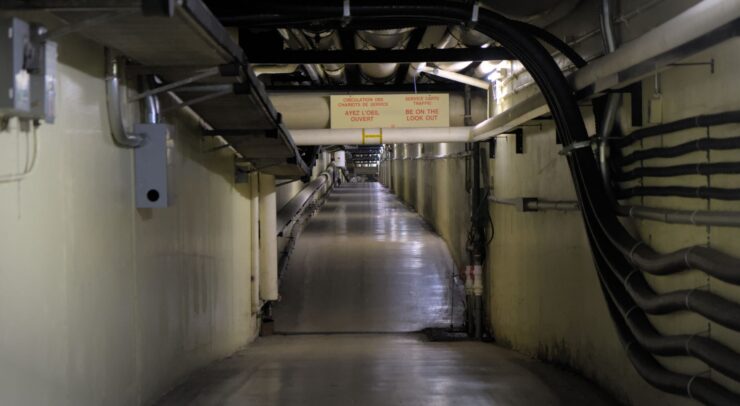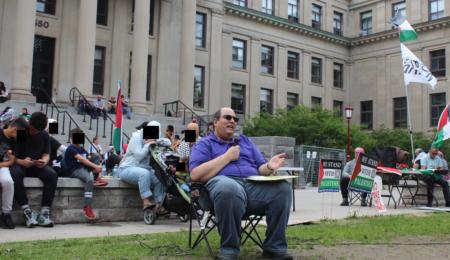THE TUNNEL IS NOT A MYTH. I’VE SEEN IT.
There is a tunnel system under campus that connects everything from Colonel By to Tabaret Hall. The Fulcrum had the opportunity to explore one of the lesser-known parts of campus.
The knowledge that there was such a tunnel system had come from an article in our October, 1978 publication, considering the potential to allow students access to the maintenance tunnels during the winter (similar to Carleton’s famed tunnel system). The 2021 Hazardous Materials Survey would later remove all doubt.
We were doubtful of getting the chance to see the tunnels. A week had gone by without any response from our leads. We managed to eventually get the chance, but even then, the hours leading up to the tour proved even more uncertain. With a little luck, the assistance of certain coordinators, and our incredible impromptu guide, this article would not have been possible.
Our journey began at what remains of Café Alternatif, a student-run coffee shop that closed in 2020. From there, we cut through the lounge and headed towards the parking lot underneath Simard Hall.
In the past, the basement of Simard was used as a coal power plant before its eventual replacement by the 1972 power plant, that is still in use today.
Through the authorized personnel door, we entered at a small junction between three paths (see on the map at the end of the article). Entering from the north, we took a sharp right.
We headed west towards the route along the O-Train. Large steam pipes ran along the ceiling, with a track of wires running at its side. This stretch of path was misleading; as for how wide it was, it soon led down a narrow flight of stairs into an even narrower path. Here, the age became more evident. The dusty wires and service pipes that had run along the ceiling now more prominently flanked both sides of the tunnel. Areas of the ceiling no longer hidden by the roads of piping exposed pockets of water damage.
The tunnel was built in 1950 to provide heat throughout the university but has seen multiple renovations since. The light olive colour paint that covered the older walls had remained in good condition since it was first plastered, but some areas definitely showed their age, being affected by the palpable heat and humid conditions. As we looked again through the photos, the olive colour paint at one point might have been white or a lighter shade of some sort.
We entered the newer tunnel renovations that were added with the O-Train installment to campus four years ago. Between the older and new tunnels, over +60 years in difference was evident. The narrow labrynthian tunnel network reminiscent of the film Silence of the Lambs had become the lower corridors of the Starship Enterprise.
There is little to no sunlight in the tunnels. Some stretches, especially the path along the train, felt like it stretched for much longer than it seemed. According to our guide, the tunnels themselves are estimated to be 3.2 km in total length.
We stopped under one of the manhole covers. The tunnels themselves are merely a few feet below the surface. Retracing our steps, we estimate this manhole cover would be near the corner of Vanier, close to the LRT. Here is a guess at which of the several covers it might be.
After continuing through the long stretch of the recently added tunnel renovation, we returned to the older section. Traversing the older paths at times proved difficult. On multiple occasions, Matt (our staff photographer) and I had to make tricky maneuvers to get through the tighter sections of the tunnels.
We found ourselves at a junction beneath the science buildings. The writing on the walls helped us get a sense of how far we had travelled, but not much. There was a tendency to lose our sense of direction after occasional sharp turns and the odd doorway.
Nearby was also one of the main tunnel sections, one of which goes uninterrupted from the Jock-Turcot University Centre to Marion Hall. These main tunnels were the subject of argument in the 1978 publication — wide enough to allow students and service carts to get through. We were lucky to catch one of these vehicles en route to another part of the university.
We were now close to the end of our tour. Our amazing guide had shown us arguably one of the coolest and unknown parts of the university. They asked us where we were headed. Deciding that we would be returning to the office, they guided us through the main corridor (as shown in previous photos) and, as if like magic, we had found ourselves in the Learning Crossroads building.
It is a strange feeling. For a 2km stretch of tunnels to exist right under our noses, campus at times can seem like such a mystery. For something so big and so old to be merely a few feet away at all times, it begs the question of what else is hidden beyond the surface level of what we see and hear.





